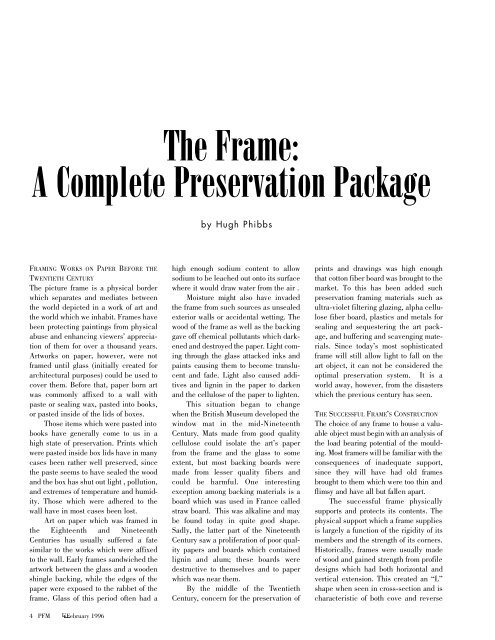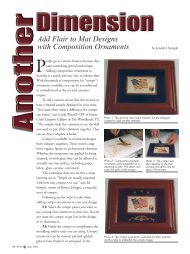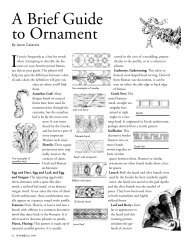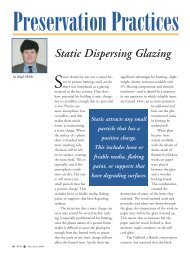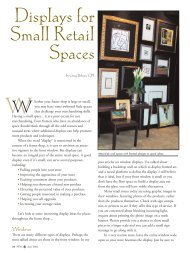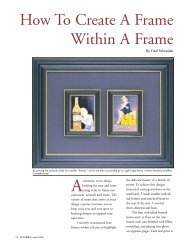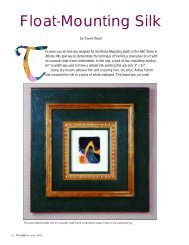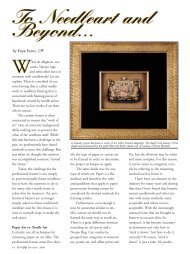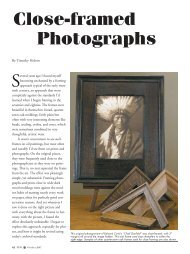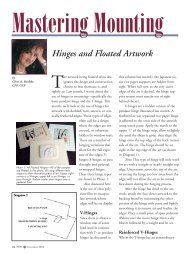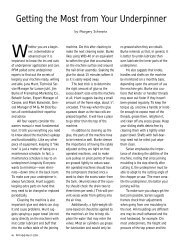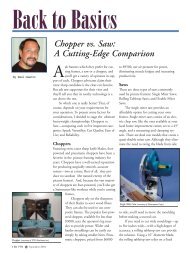TABLE OF CONTENTS - Picture Framing Magazine
TABLE OF CONTENTS - Picture Framing Magazine
TABLE OF CONTENTS - Picture Framing Magazine
Create successful ePaper yourself
Turn your PDF publications into a flip-book with our unique Google optimized e-Paper software.
The Frame:<br />
A Complete Preservation Package<br />
FRAMING WORKS ON PAPER BEFORE THE<br />
TWENTIETH CENTURY<br />
The picture frame is a physical border<br />
which separates and mediates between<br />
the world depicted in a work of art and<br />
the world which we inhabit. Frames have<br />
been protecting paintings from physical<br />
abuse and enhancing viewers’ appreciation<br />
of them for over a thousand years.<br />
Artworks on paper, however, were not<br />
framed until glass (initially created for<br />
architectural purposes) could be used to<br />
cover them. Before that, paper born art<br />
was commonly affixed to a wall with<br />
paste or sealing wax, pasted into books,<br />
or pasted inside of the lids of boxes.<br />
Those items which were pasted into<br />
books have generally come to us in a<br />
high state of preservation. Prints which<br />
were pasted inside box lids have in many<br />
cases been rather well preserved, since<br />
the paste seems to have sealed the wood<br />
and the box has shut out light , pollution,<br />
and extremes of temperature and humidity.<br />
Those which were adhered to the<br />
wall have in most cases been lost.<br />
Art on paper which was framed in<br />
the Eighteenth and Nineteenth<br />
Centuries has usually suffered a fate<br />
similar to the works which were affixed<br />
to the wall. Early frames sandwiched the<br />
artwork between the glass and a wooden<br />
shingle backing, while the edges of the<br />
paper were exposed to the rabbet of the<br />
frame. Glass of this period often had a<br />
4 PFM February 1996<br />
by Hugh Phibbs<br />
high enough sodium content to allow<br />
sodium to be leached out onto its surface<br />
where it would draw water from the air .<br />
M o i s t u re might also have invaded<br />
the frame from such sources as unsealed<br />
exterior walls or accidental wetting. The<br />
wood of the frame as well as the backing<br />
gave off chemical pollutants which darkened<br />
and destroyed the paper. Light coming<br />
through the glass attacked inks and<br />
paints causing them to become translucent<br />
and fade. Light also caused additives<br />
and lignin in the paper to darken<br />
and the cellulose of the paper to lighten.<br />
This situation began to change<br />
when the British Museum developed the<br />
window mat in the mid-Nineteenth<br />
Century. Mats made from good quality<br />
cellulose could isolate the art’s paper<br />
from the frame and the glass to some<br />
extent, but most backing boards were<br />
made from lesser quality fibers and<br />
could be harmful. One intere s t i n g<br />
exception among backing materials is a<br />
board which was used in France called<br />
straw board. This was alkaline and may<br />
be found today in quite good shape.<br />
Sadly, the latter part of the Nineteenth<br />
Century saw a proliferation of poor quality<br />
papers and boards which contained<br />
lignin and alum; these boards were<br />
destructive to themselves and to paper<br />
which was near them.<br />
By the middle of the Tw e n t i e t h<br />
Century, concern for the preservation of<br />
prints and drawings was high enough<br />
that cotton fiber board was brought to the<br />
market. To this has been added such<br />
preservation framing materials such as<br />
ultra-violet filtering glazing, alpha cellulose<br />
fiber board, plastics and metals for<br />
sealing and sequestering the art package,<br />
and buffering and scavenging materials.<br />
Since today’s most sophisticated<br />
frame will still allow light to fall on the<br />
art object, it can not be considered the<br />
optimal preservation system. It is a<br />
world away, however, from the disasters<br />
which the previous century has seen.<br />
TH E SU C C E S S F U LFR A M E’S CO N S T R U C T I O N<br />
The choice of any frame to house a valuable<br />
object must begin with an analysis of<br />
the load bearing potential of the moulding.<br />
Most framers will be familiar with the<br />
consequences of inadequate support ,<br />
since they will have had old frames<br />
b rought to them which were too thin and<br />
flimsy and have all but fallen apart .<br />
The successful frame physically<br />
supports and protects its contents. The<br />
physical support which a frame supplies<br />
is largely a function of the rigidity of its<br />
members and the strength of its corners.<br />
Historically, frames were usually made<br />
of wood and gained strength from profile<br />
designs which had both horizontal and<br />
vertical extension. This created an “L”<br />
shape when seen in cross-section and is<br />
characteristic of both cove and reverse


